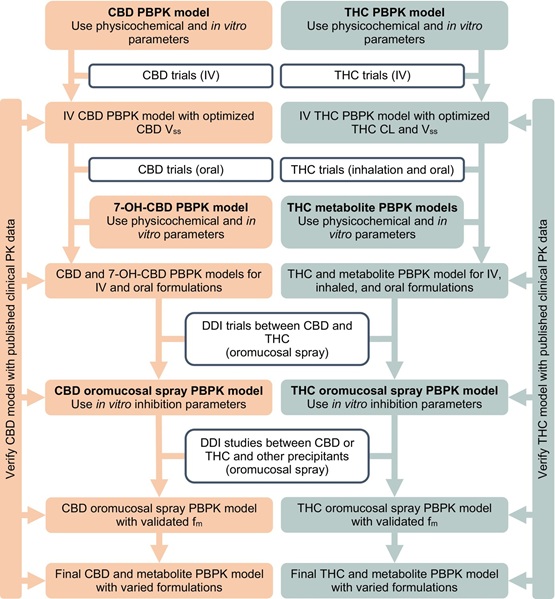Author: Zhu Zhou, PhD on April 16, 2025 
Figure: General workflow for cannabidiol (CBD) and delta-9-tetrahydrocannabinol (THC) model development. PBPK, physiologically based pharmacokinetic; IV, intravenous; Vss, volume of distribution at steady state; CL, clearance; DDI, drug-drug interaction; PK, pharmacokinetic.
The use of cannabis has rapidly increased over the past decade. Understanding how the body processes cannabinoids like THC and CBD is critical for optimizing their safety and medical use. Both compounds undergo first-pass metabolism, primarily through cytochrome P450 (CYP) enzymes and UDP-glucuronosyltransferases (UGTs). These metabolic pathways influence exposure to THC and CBD, and potential drug-drug interactions (DDIs), which can lead to changes in effectiveness and adverse events. Given the variability in cannabinoid metabolism across individuals, predicting drug exposure remains challenging, particularly with different routes of administration, such as oral, inhalation, and oromucosal spray.
To address these complexities, here we have developed and verified physiologically based pharmacokinetic (PBPK) models to predict the body's exposure to THC, CBD, and their metabolites (Figure). These models incorporate data from different doses and routes of administration, offering a comprehensive framework for estimating THC and CBD absorption, distribution, metabolism, and excretion. Notably, our models include key metabolites, such as 11-hydroxy-THC (11-OH-THC), which contributes to the psychoactive effects, and 11-nor-9-carboxy-delta-9-THC (11-COOH-THC), a potential biomarker for THC pharmacodynamics. By accurately modeling these processes, PBPK predictions provide valuable insights into THC and CBD pharmacokinetics across various doses, routes of administration, and populations.
These PBPK models can be used for other applications, including predicting changes in systemic exposure to CBD, THC, and metabolites in combination with cytochrome P450 inhibitors or inducers, as well as in specific populations, to assess potential safety concerns.

The comment feature is locked by administrator.